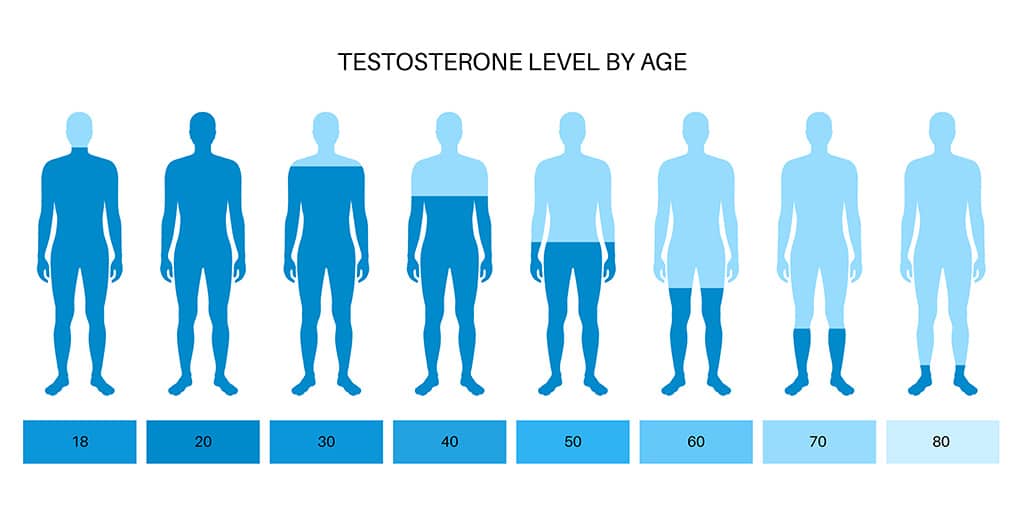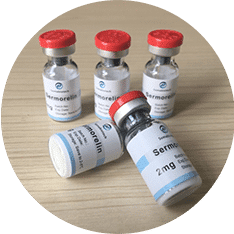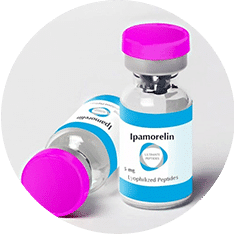
Unlock a More Youthful You With Testosterone Replacement Therapy In Seaport, NY
Aging is inevitable, and for many, it signals the beginning of a new chapter - one where you cross off bucket list items and live life to the fullest, on your own terms. However, for some men, aging is a horrible prospect, filled with chronic fatigue, irritability, and inability to perform in the bedroom. If you're concerned about life in middle age and beyond, we've got great news: there are easy, proven steps that you can take to help stop the negative effect of aging.
Global Life Rejuvenation was founded to give men a new lease on life - one that includes less body fat, fewer mood swings, and more energy as you age. If you're ready to look and feel younger, it's time to consider TRT (testosterone replacement therapy), and growth hormone peptides. These therapies for men are effective, safe, and customized to fit your goals, so you can keep loving life as you get older.
TRT, and growth hormone peptide therapies bridge the gap between your old life and the more vibrant, happier version of you. With a simple click or call, you can be well on your way to a brighter future. After all, you deserve to be the one in charge of your wellness and health. Now, you have the tools to do so - backed by science and applied by our team of TRT and HRT experts with more than 13 years of experience.

Testosterone Replacement Therapy
- Unlock A More Youthful You With Testosterone Replacement Therapy In Seaport, NY
- TRT and Anti-Aging Medicine for Men
- Common Symptoms of Low Testosterone
- Benefits of TRT and Anti-Aging Medicine for Men
- Fight Back Against Male Menopause
- Reverse Aging with Growth Hormone Peptides in Seaport, NY
- Your New, Youthful Lease on Life Starts Here
TRT and Anti-Aging Medicine for Men in Seaport, NY
For men, getting older comes with its perks, like living life on their own terms and not having to "sweat the small stuff" day in and day out. At the same time, there are aspects of aging that men dread, like hormonal changes. Yes, you read that right – men, not just women, go through hormonal changes as they age. For men, the biggest change involves a drop in testosterone.
Lower levels of testosterone can wreak havoc on a male's mind and body and when left untreated, can result in symptoms like:
- Erectile Dysfunction
- Depression
- Irritability
- Low Sex Drive
- Hair Loss
- Less Muscle Mass
- Problems Concentrating
Those symptoms are concerning, but with testosterone replacement therapy and anti-aging medicine, many males improve their quality of life with age. The good news is that TRT and anti-aging meds aren't only reserved for "old guys." In fact, there's no magic age at which men should start thinking about hormone replacement therapy. Everyone's body is different, so if you're experiencing the above conditions in your mid-30s, TRT could be a viable solution when you consult with a doctor.


What is Testosterone?
Testosterone is a crucial hormone for men and plays an important role throughout the male lifespan. Most of a male's testosterone is produced through the testicles. Also called the male sex hormone, testosterone starts playing its part during puberty.
When a male goes through puberty, testosterone helps males develop:
- Facial Hair
- Body Hair
- Deeper Voice
- Muscle Strength
- Increased Libido
- Muscle Density
As boys turn to men and men grow older, testosterone levels deplete naturally. Sometimes, events like injuries and chronic health conditions like diabetes can lower testosterone levels. Unfortunately, when a man loses too much T, it results in hypogonadism. When this happens, the testosterone must be replaced, or the male will suffer from symptoms like muscle loss, low libido, and even depression.

How Does TRT Work?
TRT is exactly what it sounds like: a treatment option for men that replaces testosterone so that your body regulates hormones properly and restores balance to your life. Also called androgen replacement therapy, TRT alleviates the symptoms that men experience with low T.
Originally lab-synthesized in 1935, testosterone has grown in popularity since it was produced. Today, TRT and other testosterone treatments are among the most popular prescriptions in the U.S.
Without getting too deep into the science, TRT works by giving your body the essential testosterone it needs to function correctly. As the primary androgen for both males and females, testosterone impacts many of the body's natural processes – especially those needed for overall health. For example, men with low T are more prone to serious problems like cardiovascular disease and even type-2 diabetes.
When your body quits making enough testosterone, it causes your health to suffer until a solution is presented. That's where TRT and anti-aging medicine for men can help. TRT helps balance your hormones and replenish your depleted testosterone. With time, your body will begin to heal, and many symptoms like low libido and irritability begin to diminish.

What Causes Low T?
For men, aging is the biggest contributor to lower testosterone levels, though there are other causes like obesity, drug abuse, testicular injuries, and certain prescribed medications. Sometimes, long-term health conditions like AIDS, cirrhosis of the liver, and kidney disease can lower testosterone levels.
When a man's testosterone levels drop significantly, it alters his body's ratio of estrogen and testosterone. Lower testosterone levels cause more abdominal fat, which in turn results in increased aromatase, which converts even more testosterone into estrogen.
If you're concerned that you might have low T, you're not alone. Millions of men in the U.S. feel the same way. The best way to find out if your testosterone is low is to get your levels tested.
For sustainable testosterone replacement therapy benefits, you must consult with hormone doctors and experts like those you can find at Global Life Rejuvenation. That way, you can find the root cause of your hormone problems, and our team can craft a personalized HRT plan tailored to your needs.
Common Symptoms of Low Testosterone
Are you used to blasting through a productive day and accomplishing all your daily goals? Do you find yourself losing muscle mass and the craving to be intimate with your partner? Does your partner complain about how irritable you have become? If you're not usually a curmudgeon, your body could be giving you a sign. It could be time to speak with a doctor about TRT and anti-aging medicine for men in Seaport, NY.
If you're experiencing any of the following symptoms, you might be battling against low testosterone:

Low Sex Drive
One of the most common reasons that men choose TRT is because they have lost that "spark" with their partner. It's not easy for a man to hear that they're not performing like they used to. Intimacy is a powerful part of any relationship. When a once-healthy sex life dwindles, it can cause serious relationship issues.
The good news is that low libido doesn't have to be a permanent problem. TRT and anti-aging medicines help revert hormone levels back into their normal range. When this happens, many men have a more enjoyable life full of intimacy and sex drive.

Inability to Achieve and Maintain an Erection
Weak erections – it's an uncomfortable subject for many men in the U.S. to talk about. It's even worse to experience first-hand. You're in the midst of an intimate moment, and you can't do your part. Despite being perfectly normal, many men put blame and shame upon themselves when they can't achieve an erection. And while the inability to perform sexually can be caused by poor diet, obesity, and chronic health conditions, low testosterone is often a contributing factor.
Fortunately, weak erections are a treatable condition. The best way to regain your confidence and ability in bed is to speak with your doctor. Once any underlying conditions are discovered, options like TRT may be the best course of treatment.
Hair Loss

Loss of Strength and Muscle Mass
Do you find it harder and harder to work out and lift weights in the gym? Are you having problems lifting heavy items that you once had no problem lifting?
Recent studies show that when men are inactive, they lose .5% of muscle strength every year, from ages 25 to 60. After 60, muscle loss doubles every decade. While some muscle loss is common as men age, a significant portion can be tied to low testosterone levels. When a man's T levels drop, so does his muscle mass.
Testosterone is a much-needed component used in gaining and retaining muscle mass. That's why many doctors prescribe TRT Seaport, NY, for men having problems with strength. One recent study found that men who increased their testosterone levels using TRT gained as much as 2.5 pounds of muscle mass.
Whether your gym performance is lacking, or you can't lift heavy items like you used to, don't blame it all on age. You could be suffering from hypogonadism.

Hair Loss
If you're like millions of other men in their late 20s and 30s, dealing with hair loss is a reality you don't want to face. Closely related to testosterone decline and hormone imbalances, hair loss is distressing for many men. This common symptom is often related to a derivative of testosterone called DHT. Excess amounts of DHT cause hair follicles to halt their production, causing follicles to die.
Because hair located at the front and crown is more sensitive to DHT, it grows slower than other follicles and eventually stops growing permanently. Thankfully, TRT and anti-aging treatments for men in Seaport, NY, is now available to address hair loss for good.
While it's true that you can't change your genes, you can change the effects of low testosterone on your body. Whether you're suffering from thinning hair or hair loss across your entire head, TRT and other hormone therapies can stop hair loss and even reverse the process.

Gynecomastia
Also called "man boobs," gynecomastia is essentially the enlargement of male breast tissue. This increase in fatty tissue is often caused by hormonal imbalances and an increase in estrogen. For men, estrogen levels are elevated during andropause. Also called male menopause, andropause usually happens because of a lack of testosterone.
If you're a man between the ages of 40 and 55, and you're embarrassed by having large breasts, don't lose hope. TRT is a safe, effective way to eliminate the underlying cause of gynecomastia without invasive surgery. With a custom HRT and fitness program, you can bring your testosterone and estrogen levels back to normal before you know it.

Decreased Energy
Decreased energy was once considered a normal part of aging. Today, many doctors know better. Advances in technology and our understanding of testosterone show that low T and lack of energy often go hand-in-hand.
If you're struggling to enjoy activities like playing with your kids or hiking in a park due to lack of energy, it could be a sign of low T. Of course, getting tired is perfectly normal for any man. But if you're suffering from continual fatigue, a lack of enjoyment, or a decrease in energy, it might be time to speak with a doctor.
Whether you're having a tough time getting through your day or can't finish activities you used to love, TRT could help.

Lack of Sleep
A study from 2011 showed that men who lose a week's worth of sleep can experience lowered testosterone levels – as much as 15%, according to experts. Additional research into the topic found almost 15% of workers only get five hours of sleep (or less) per night. These findings suggest that sleep loss negatively impacts T levels and wellbeing.
The bottom line is that men who have trouble sleeping often suffer from lower testosterone levels as a result. If you find yourself exhausted at the end of the day but toss and turn all night long, you might have low T.
TRT and anti-aging medicines can restore your T levels back to normal, which can help you sleep better with proper diet and exercise.

Depression
You're feeling down about everything, and there's no solid explanation for why you're in such a crummy mood. Your daily life is great and full of success, but you can't help but feel unexcited and unmotivated. If you're experiencing symptoms like these, you may be depressed – and it may stem from low testosterone.
A research study from Munich found that men with depression also commonly had low testosterone levels. This same study also found that depressed men had cortisol levels that were 67% higher than other men. Because higher cortisol levels lead to lower levels of testosterone, the chances of severe depression increase.
Depression is a very real disorder and should always be diagnosed and treated by your doctor. One treatment option gaining in popularity is TRT for depression. Studies show that when TRT is used to restore hormone levels, men enjoy a lighter, more improved mood. That's great news for men who are depressed and have not had success with other treatments like anti-depression medicines, which alter the brain's chemistry.

Inability to Concentrate
Ask anyone over the age of 50 how their memory is, and they'll tell you it wasn't what it used to be. Memory loss and lack of concentration occur naturally as we age – these aren't always signs of dementia or Alzheimer's.
However, what many men consider a symptom of age may be caused by low testosterone. A 2006 study found that males with low T levels performed poorly on cognitive skill tests. These results suggest that low testosterone may play a part in reducing cognitive ability. If you're having trouble staying on task or remembering what your schedule is for the day, it might not be due to your age. It might be because your testosterone levels are too low. If you're having trouble concentrating or remembering daily tasks, it could be time to talk to your doctor.
Why? The aforementioned study found that participating men experienced improved cognitive skills when using TRT.

Weight Gain
Even though today's society is more inclusive of large people, few adults enjoy gaining weight as they age. Despite their best efforts, many men just can't shed the extra pounds around their midsections, increasing their risk of heart disease and cancer.
Often, male weight gain is caused by hormone imbalances that slow the metabolism and cause weight to pile on. This phase of life is called andropause and happens when there is a lack of testosterone in the body. Couple that with high cortisol levels, and you've got a recipe for flabby guts and double chins.
Fortunately, TRT treatments and physician-led weight loss programs can correct hormone imbalances and lead to healthy weight loss for men.
Benefits of TRT and Anti-Aging Medicine for Men in Seaport, NY
The benefits of hormone replacement therapy for men are numerous. TRT not only grants relief from low-T symptoms but can help give protection against age-related diseases. Additionally, doctors now recognize male testosterone as an important role in alleviating depression.
Some of the most exciting benefits of TRT can include:
- Reduction in Body Fat
- Increased Strength
- More Muscle Mass
- More Energy
- Lower Risk of Erectile Dysfunction
- Higher Sperm Production
- Healthy Reproductive Tissues
- Lower Risk of Heart Disease and Diabetes
- Lower Risk of Anxiety
- Lower Risk of Depression


Fight Back Against Male Menopause
Because men do not go through a specific period of hormonal changes like women do (called menopause), many doctors refer to "male menopause" as androgen decline. This is just another term for low testosterone, but like female menopause, the symptoms can be serious and affect your quality of life.
The best way to fight back against male menopause is with male HRT treatment from Global Life Rejuvenation. We provide the following HRT treatments for men:
- Testosterone Replacement Therapy (TRT)
- Sermorelin (Sermorelin Acetate)
- Human Growth Hormone (HGH)
Our treatment options are personalized for your body and are available as creams, gels, injectables, and implantable pellets. To find out if testosterone replacement therapy is safe for you, contact Global Life Rejuvenation today to schedule your comprehensive testing and anti-aging treatment consultation.
Reverse Aging with Growth Hormone Peptides in Seaport, NY
Growth hormone peptides are an innovative therapy that boosts the natural human growth hormone production in a person's body. These exciting treatment options help slow down the aging process and give you a chance at restoring your youth.

What is Sermorelin?
Sermorelin is a synthetic hormone peptide, like GHRH, which triggers the release of growth hormones. When used under the care of a qualified physician, Sermorelin can help you lose weight, increase your energy levels, and help you feel much younger.

Benefits of Sermorelin
Human growth hormone (HGH) therapy has been used for years to treat hormone deficiencies. Unlike HGH, which directly replaces declining human growth hormone levels, Sermorelin addresses the underlying cause of decreased HGH, stimulating the pituitary gland naturally. This approach keeps the mechanisms of growth hormone production active.
Benefits of Sermorelin include:
- Better Immune Function
- Improved Physical Performance
- More Growth Hormone Production
- Less Body Fat
- Build More Lean Muscle
- Better Sleep

What is Ipamorelin?
Ipamorelin helps to release growth hormones in a person's body by mimicking a peptide called ghrelin. Ghrelin is one of three hormones which work together to regulate the growth hormone levels released by the pituitary gland. Because Ipamorelin stimulates the body to produce growth hormone, your body won't stop its natural growth hormone production, which occurs with synthetic HGH.
Ipamorelin causes growth hormone secretion that resembles natural release patterns rather than being constantly elevated from HGH. Because ipamorelin stimulates the natural production of growth hormone, our patients can use this treatment long-term with fewer health risks.

Benefits of Ipamorelin
One of the biggest benefits of Ipamorelin is that it is suitable for both men and women. It provides significant short and long-term benefits in age management therapies, boosting patients' overall health, wellbeing, and outlook on life. When growth hormone is produced by the pituitary gland using Ipamorelin, clients report amazing benefits.
Some of those benefits include:
- Powerful Anti-Aging Properties
- More Muscle Mass
- Less Unsightly Body Fat
- Deep, Restful Sleep
- Increased Athletic Performance
- More Energy
- Less Recovery Time for Training Sessions and Injuries
- Enhanced Overall Wellness and Health
- No Significant Increase in Cortisol
Your New, Youthful Lease on Life Starts Here
Whether you are considering our TRT services, HRT for women, or our growth hormone peptide services, we are here to help. The first step to turning back the hand of time starts by contacting Global Life Rejuvenation.
Our friendly, knowledgeable TRT and HRT experts can help answer your questions and walk you through our procedures. From there, we'll figure out which treatments are right for you. Before you know it, you'll be well on your way to looking and feeling better than you have in years!
 866-793-9933
866-793-9933
Request a Consultation
Latest News in Seaport, NY
Seaport Residences Remains Indefinitely Stalled at 161 Maiden Lane in Financial District, Manhattan
Michael Young and Matt Pruznickhttps://newyorkyimby.com/2023/11/seaport-residences-remains-indefinitely-stalled-at-161-maiden-lane-in-financial-district-manhattan.html
Leading off our Turkey Week rundown of prominent stalled projects in New York City is Seaport Residences, a 60-story residential skyscraper at 161 Maiden Lane along the border of Lower Manhattan’s Financial District and the South Street Sea...
Leading off our Turkey Week rundown of prominent stalled projects in New York City is Seaport Residences, a 60-story residential skyscraper at 161 Maiden Lane along the border of Lower Manhattan’s Financial District and the South Street Seaport District. Designed by Hill West Architects and developed by Fortis Property Group, the slender 670-foot-tall tower, originally dubbed One Seaport, was planned to span 200,000 square feet and yield 80 condominium units with interiors by Groves & Co. Ray Builders was the last general contractor to work on the beleaguered project, which stands on a narrow site bound by South Street and Maiden Lane, directly across from the FDR Drive and the East River.
The skyscraper has languished with no progress for the last three years, and there are no indications of work resuming anytime soon. After breaking ground nearly a decade ago, the project famously unraveled in early 2019 over reports that the reinforced concrete superstructure was leaning three inches to the north, leading to a public spat between Fortis and the original contractor, Pizzarotti LLC. Despite its lean, the structure was deemed safe and curtain wall installation resumed later that year under the supervision of a new contractor, Ray Builders, but by our update in September of 2020, significant portions of the glass envelope had been removed for unclear reasons.
Today, the superstructure looms as a forlorn skeleton over the East River waterfront, its future in doubt.
Fortis Property Group originally acquired the property for $64 million was anticipating a sellout of $272 million on the condominium units. It remains unclear if and when work on Seaport Residences will resume.
Subscribe to YIMBY’s daily e-mail
Follow YIMBYgram for real-time photo updates Like YIMBY on Facebook Follow YIMBY’s Twitter for the latest in YIMBYnews
Permits have been filed for a six-story residential building at 1152 Lafayette Avenue in Bushwick, Brooklyn. Located between Broadway and Bushwick Avenue, the interior lot is near the Knickerbocker Avenue subway station, serviced by the M train. Richard Zavlyanov of Diamond Development Group is listed as the owner behind the applications.
The proposed 60-foot-tall development will yield 10,483 square feet designated for residential space. The building will have ten residences, most likely condos based on the average unit scope of 1,048 square feet. The masonry-based structure will also have a cellar and a 32-foot-long rear yard.
Robert Bianchini of ARC Architecture + Design Studio is listed as the architect of record.
Demolition permits have not been filed yet. An estimated completion date has not been announced.
Subscribe to YIMBY’s daily e-mail
Follow YIMBYgram for real-time photo updates Like YIMBY on Facebook Follow YIMBY’s Twitter for the latest in YIMBYnews
Spanish multinational financial services company BBVA has announced plans to relocate its headquarters to Two Manhattan West, a recently completed 58-story office skyscraper in the Manhattan West complex in Midtown West. The move is set to be finalized by the end of 2024.
BBVA’s new headquarters is set to occupy roughly 74,000 square feet across two floors in Two Manhattan West. The skyscraper offers modern amenities, including fitness centers, conference facilities, and outdoor terraces, and is strategically located near major transportation hubs and city attractions.
A key aspect of BBVA’s move is the alignment with its sustainability goals. Two Manhattan West, designed by Skidmore, Owings & Merrill, is LEED-Gold certified and powered entirely by renewable energy, specifically run-of-river hydropower. This eco-friendly approach is in line with Brookfield Properties‘ commitment to transitioning its U.S. office portfolio to zero-emissions electricity by 2026.
With BBVA on board, Two Manhattan West has now achieved over 80 percent occupancy, joining other major tenants in the area and demonstrating the building’s appeal to leading global firms.
Subscribe to YIMBY’s daily e-mail
Follow YIMBYgram for real-time photo updates Like YIMBY on Facebook Follow YIMBY’s Twitter for the latest in YIMBYnews
South Street Seaport Museum Announces free February Book Club event: Here is New York by E. B. White
Divya Sarmahttps://patch.com/new-york/upper-east-side-nyc/calendar/event/20240226/ddeb49db-6887-4d75-8c9b-d69cfc555656/south-street-seaport-museum-announces-free-february-book-club-event-here-is-new-york-by-e-b-white
South Street Seaport Museum announces the February selection of the Seaport Museum Book Club is Here is New York by E. B. White. The free event will be held on February 26, 2024, at 6:30pm at McNally Jackson Seaport, 4 Fulton Street. ...
South Street Seaport Museum announces the February selection of the Seaport Museum Book Club is Here is New York by E. B. White. The free event will be held on February 26, 2024, at 6:30pm at McNally Jackson Seaport, 4 Fulton Street. seaportmuseum.org/bookclub
In honor of the season of love, the Seaport Museum Book Club invites you to delve into the heartwarming selection, Here is New York. This timeless piece by E. B. White serves as the quintessential love letter to New York City, capturing its essence with perceptive, humorous, and nostalgic insights during a stroll around Manhattan in 1948.
Join this lively discussion on White’s masterful work, and rediscover your affection for the city. Recognized by The New York Times as one of the ten best books ever written about the metropolis, and hailed by The New Yorker as “the wittiest essay, and one of the most perceptive, ever done on the city,” this publication promises to rekindle your love affair with the vibrant and ever-evolving cityscape. Don’t miss the chance to share your thoughts and reflections on this literary gem with fellow enthusiasts. You don’t have to read the full essay to enjoy the event––everyone is welcome!
Here is New York is available for purchase at most bookstores. Register for the January meeting of the Seaport Museum Book Club today to receive a 10% off discount code for online orders of the book at McNally Jackson Books. mcnallyjackson.com/book/9781892145024
About the South Street Seaport Museum
The South Street Seaport Museum, located in the heart of the historic seaport district in New York City, preserves and interprets the history of New York as a great port city. Founded in 1967, the Museum houses an extensive collection of works of art and artifacts, a maritime reference library, exhibition galleries and education spaces, working 19th century print shops, and an active fleet of historic vessels that all work to tell the story of “Where New York Begins.” seaportmuseum.org
#
#SouthStreetSeaportMuseum #WhereNewYorkBegins
Sea Creatures From the Deep, Captured in Glass, Rise at Mystic Seaport
Meredith Mendelsohnhttps://www.nytimes.com/2023/11/18/arts/design/glass-artisans-mystic-connecticut.html
An enterprising father and son in Dresden, Germany, Leopold and Rudolf Blaschka, found success in the 19th century hand-blowing glass models of marine invertebrates and selling them to universities and natural history museums around the world, from New England to Tokyo. Harvard and ...
An enterprising father and son in Dresden, Germany, Leopold and Rudolf Blaschka, found success in the 19th century hand-blowing glass models of marine invertebrates and selling them to universities and natural history museums around the world, from New England to Tokyo. Harvard and Cornell bought around a thousand, in total, by mail order in the 1870s and 1880s.
As it turns out, many of those same types of invertebrates were also traveling the world — and they still are, transported by maritime traffic, clinging to the hulls of ships and riding in their ballasts. Some of those native European creatures, modeled in glass long before terms like invasive species and biofouling were coined, are now thriving in Stonington Harbor in the Mystic River Estuary, off the coast of Connecticut.
Those well-traveled species are the inspiration behind “Spineless: A Glass Menagerie of Blaschka Marine Invertebrates” at the Mystic Seaport Museum nearby, through Sept. 2024. Included in the rare loan of more than 40 delicate Blaschka models, mostly from Harvard’s Museum of Comparative Zoology, are several whose pesky counterparts are blanketing nearby docks and pilings.
It’s the first time that the Blaschka models have been given so much historical context, from 19th-century sailors’ journals and jars of preserved specimen to zoological illustrations that informed the Blaschkas. The museum even included a few related contemporary art works.
“It’s a way for us to authentically talk about ocean health within our mission and within our site,” Christina Brophy, senior vice president of curatorial affairs at the Mystic Seaport Museum, said while sitting out on one of its sunny decks last month. The largest maritime museum in the United States, it’s better known for whaling vessels than ecological research. But one of the show’s curators, James T. Carlton, director emeritus of the Williams-Mystic Coastal & Ocean Studies Program of Williams College and the Mystic museum, has been scraping ship hulls since 1982 and cataloging his findings to record the area’s changing biodiversity.
The Blaschka glass models are fragile and rarely travel. But the museum was able to secure a wide variety, including sea anemones, octopuses, squids, tube worms and sea squirts.
“We were looking for species that had both a local story and a global story, species that have been spread around the world by ships for centuries,” said Carlton, who collaborated with the museum’s curator of collections, Krystal Rose.
In an era before scuba diving, underwater cameras, or mass-produced textbooks, the Blaschkas’ lifelike sea creatures were the gold standard of marine zoology teaching models. Invertebrates could not be taxidermied, and collected specimen lose their color and form when preserved in jars, as we can see from the many on view here, including some dating to the 19th century.
Leopold (1822—95) and Rudolf (1857–1939) offered around 700 marine invertebrate species, which they sold through catalogs like Ward’s Natural Science Establishment of Rochester, N.Y. Created by the process of lampworking — glass blowing using an open flame — and then painstakingly hand-painted, the models were designed to look more realistic than beautiful. But they are works of art, with their multiple layers of glass and fine frills, fringes, suckers and tentacles. (They rarely appear on the market but a Portuguese man o’war brought around $13,000, and a jellyfish, around $20,000, at a Christie’s London auction in 2019.)
“They were a more or less accurate rendering of the species,” said James Hanken, a professor in Harvard’s Museum of Comparative Zoology, who spearheaded the cleaning, restoration, and display of that institution’s 434 Blaschka models in the early 2000s, after finding them stored away in dusty boxes.
“The Blaschkas were very, very, specific about their parts,” said Elizabeth Brill, a glassworker and marine biology field technician who restored Harvard’s collection (and Cornell’s before that). “They knew exactly how long each tentacle should be, from one species of jellyfish to the next.” Brill restored the one jellyfish on view, which is missing some of its fragile tentacles (replicated by the Blaschkas by coating wires in glass).
Leopold, who hailed from Bohemian glassworkers, started out making jewelry and then glass eyeballs both for humans and taxidermy. He also made stunning glass flowers, producing more than 4,000 with his son for Harvard. What’s surprising is that these two artists in landlocked Dresden could have replicated marine species so accurately.
Leopold did in fact glimpse live jellyfish in all their glass-like luminosity years before he started making them, while sailing across the Atlantic to the U.S. in the early 1850s. By the late 1870s he and his son had acquired a seawater aquarium and ordered live animals that came wrapped in seaweed from marine stations throughout Europe. (Much of what we know of them comes from their archives at the Corning Museum of Glass.)
Zoological illustrations were also essential. Early on, Leopold emulated drawings of anemones by Philip Henry Gosse, the Victorian naturalist and collector of marine species known as the inventor of the modern aquarium (and for trying to reconcile his creationist beliefs with his scientific findings). Later, the Blaschkas borrowed illustrations from Ernst Haeckel, a German zoologist and skilled artist who cataloged many of the thousands of marine species pulled up by the HMS Challenger, a British ship that spent three and a half years, starting in 1872, gathering data from the ocean’s depths.
“There was so much documentation of marine invertebrates in the 19th century,” Rose said. “Citizen scientists were walking the shores noticing these things.”
This escalating fascination with the sea helped fuel the Blaschkas’ success, “along with Darwin’s publication of the ‘Origin of Species’ and explorations going to all kinds of places,” Hanken said.
With those explorations, of course, came marine creatures as invasive as the humans leading them.
The exhibition includes several models of invasive sea squirts, or tunicates, named for the leathery tunic-like sheath that protects their soft bodies. They tend to grow in clusters and create a slimy blanket that can befoul aquaculture and create drag on ship hulls. And then there are the living ecosystems they disturb.
“We generally don’t like to see invaders,” Carlton told me while watching recent video footage of some of the sea squirts swaying in the tidal surge in nearby Stonington Harbor, where they blanket docks and pilings. “They could replace or displace a native species. And it might have a cascade effect.” The most visible, lightbulb sea squirts, named for their translucent white tubelike forms that seem to glow, are native to Europe but were discovered in Long Island Sound in the early 2000s. The Blaschkas’ version is encased nearby and shows three colorless glass tubes sprouting from a base, each filled with tiny glass coils that seem like precursors of fluorescent light bulbs.
The Blaschkas’ models brought attention to the ocean’s changing biodiversity when a Cornell professor, Drew Harvell, set off on a scuba diving journey in 2013 to see how many live versions of the Blaschkas’ models she could locate. Coral reefs damaged by pollution, blast fishing and ocean warming were among her finds. A book and film documented the project.
Warming waters are also enabling nonnative species to survive where they previously could not, Carlton said. What we can do, as individuals, he said, is “try to clean as well as possible whatever we’re moving or transporting” that might have associated species tagging along.
Once again, “our eyes on the shore are citizen scientists,”Rose said, pulling up an app on her phone, inaturalist, a nonprofit organization that’s building a crowdsourced database detailing where and when living things appear. “Anyone can report a species sighting, and then it gets confirmed by others,” she said. Carlton added, “one step ahead of science.”
Port of New York and New Jersey moves the most TEUs since October 2022
Lori Ann LaRoccohttps://www.freightwaves.com/news/port-of-new-york-and-new-jersey-moves-the-most-teus-since-october-2022
Peak season for the Port of New York and New Jersey has arrived. Not only did the port take the top spot for containers moved in July, but it was the port’s highest monthly total since October 2022. A total of 725,479 TEUs were processed in July.Rick Cotton, Port Authority executive director, tells American Shipper it was extremely gratifying to see the strong performance that made the port the busiest in the nation for July.“The Port of New York and New Jersey’s strong performance in July as the peak shipping...
Peak season for the Port of New York and New Jersey has arrived. Not only did the port take the top spot for containers moved in July, but it was the port’s highest monthly total since October 2022. A total of 725,479 TEUs were processed in July.
Rick Cotton, Port Authority executive director, tells American Shipper it was extremely gratifying to see the strong performance that made the port the busiest in the nation for July.
“The Port of New York and New Jersey’s strong performance in July as the peak shipping season gets underway underscores our business partners’ confidence in the East Coast’s biggest port to move their goods quickly and reliably,” Cotton said. “Our deep relationships and collaboration with all links of the regional supply chain continue to reap tangible benefits for our stakeholders who have retained their business here in New York-New Jersey even as the impact of softening global trade is felt elsewhere.”
Based on current port data compiled by American Shipper, the East Coast and Gulf ports are strongly favored over West Coast ports. The Port of Los Angeles announced a drop of 26% in twenty-foot equivalent units processed year over year in July. Compared to June, there was a drop of 148,744 TEUs processed in July. The ports of Savannah, Georgia, and Houston both recorded increases over the same time frame. The Port of Houston was up year over year with its July container processing.
New York and New Jersey Port officials tells American Shipper they saw a 40% increase in shipments of apparel, toys, games and sporting equipment. The port also moved 9.4% more cargo this July compared to July 2019.
The strength of trade arriving at the Port of New York and New Jersey and the Gulf and East Coast ports continues to flow through the Panama Canal despite the current congestion. The Panama Canal is a critical trade link for U.S. shippers heading to Gulf and East Coast ports.
The Panama Canal Authority (ACP) tells American Shipper, “The Canal continues to be the preferred route for the container carrier segment which has been minimally impacted by the adjustments to draft and transits associated with the measures to conserve water.”
“New York/New Jersey, Savannah and Houston are the most important ports in the U.S. Gulf/East Coast, accounting for almost 60% of total imports, and moving 70% of Eastern Asia imports in July 2023,” the ACP added. “Currently, all of the 18 liner services deployed in the Asia — U.S. Gulf/East Coast route via Panama Canal call at either New York/New Jersey, Savannah or Houston. The Panama Canal has maintained a strong participation in this trade lane — with vessels capacity up to 16,000 TEU — because of the value offered in terms of connectivity, distance, and time”.
Even water conservation measures that have increased wait times upwards of two weeks for some vessels to pass are not dissuading shippers from using the preferred water route.
The ACP added, “Vessels that book in advance, such as containerships, are transiting as scheduled through the Panama Canal, without significant delays.”
The U.S. is the largest user of the Panama Canal, with total U.S. commodity export and import containers representing about 73% of Panama Canal traffic. Forty percent of all U.S. container traffic travels through the canal every year, about $270 billion in cargo. U.S. energy and agriculture also use this waterway to transfer goods.
David Chang’s Momofuku Ssäm Bar Is Closing
Melissa McCarthttps://ny.eater.com/2023/9/8/23864855/momofuku-ssam-bar-closing-david-chang-seaport-nyc
In 2021, David Chang decided to move his hugely popular Momofuku Ssäm Bar to the Seaport, a neighborhood in transition — one associated with tourists, finance, and the absence of Fulton Fish Market following its 180-year tenure. Two years later, the restaurant has announced on Instagram that it is closing at the end of the month. The last day of service is September 30.“We will ...
In 2021, David Chang decided to move his hugely popular Momofuku Ssäm Bar to the Seaport, a neighborhood in transition — one associated with tourists, finance, and the absence of Fulton Fish Market following its 180-year tenure. Two years later, the restaurant has announced on Instagram that it is closing at the end of the month. The last day of service is September 30.
“We will always be grateful for the teams past and present who made Ssäm Bar such a special restaurant over the past 17 years,” reads the Instagram announcement, citing its roots in the creation of the global brand, Momofuku. “It is hard to overstate the impact Ssäm Bar had on Momofuku and beyond.” Eater has contacted Momofuku for more information on the closure.
Ssäm Bar relocated to the Seaport after 15 years in the East Village. The restaurant’s lease was expiring; instead of renewing it, the team moved the restaurant into a space that was home to another Momofuku restaurant, Bar Wayō, which opened at the Seaport in 2019. The move was announced early in the pandemic in tandem with the closing of the Korean Italian restaurant Nishi, open since 2016.
When Ssäm Bar opened in April 2021, the new location felt like “a monogrammed polo shirt of its formerly raffish self,” Eater critic Ryan Sutton wrote of the move. While the menu and space saw many iterations over the years, in the most recent one, “the group has managed to keep its creative culinary soul intact, slinging gelatinous raw crab platters, Korean-Lebanese wrap sandwiches, and buttery imitation crab rolls in places where one might otherwise expect a $70 strip steak.”
Momofuku Ssäm Bar opened in 2006 in the East Village at 207 Second Avenue, near East 13th Street, two years after the debut of the scrappy Momofuku Noodle Bar, a restaurant that was huge in shaping how New Yorkers dined. This, too, became a quintessential restaurant, despite its ever-changing menu that helped drive New Yorkers’ quest for new menu items from old favorite restaurants.
Two years after it opened, the New York Times called Ssäm Bar “the cornerstone of the Chang legend,” wrote then-critic Frank Bruni. “It justly enshrined Mr. Chang as a chef who went further than any of his peers in wedding serious, sometimes challenging food and an ultra-casual, spontaneous dining ethos in tune with unbound times.”
The move to the Seaport tracked with an infusion of money into the Momofuku brand in 2016, marking a shift from opening in a residential neighborhood to billion-dollar developments like Columbus Circle, Hudson Yards, and the Seaport’s Pier 17.
After the restaurant closes, Momofuku will be down to three restaurants in New York City: Noodle Bar, Ko, and the fast-casual, made-for-the-mall Bāng Bar, which opened in Time Warner Center in 2018. There’s also a Momofuku in Las Vegas and Majordomo in Los Angeles.
Disclaimer:


